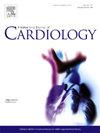Machine learning risk-prediction model for in-hospital mortality in Takotsubo cardiomyopathy
IF 3.2
2区 医学
Q2 CARDIAC & CARDIOVASCULAR SYSTEMS
引用次数: 0
Abstract
Background
Takotsubo cardiomyopathy (TC) is an acute heart failure syndrome characterized by transient left ventricular dysfunction, often triggered by stress. Data on risk scores predicting mortality in TC is sparse. We developed a machine-learning risk score model to predict in-hospital mortality in patients with TC.
Methods
The National Inpatient Sample (NIS) database 2016–2020 was queried to identify adult patients (≥18 years) with TC using ICD-10 code I51.81. The primary outcome was in-hospital mortality. The dataset was randomly split into training (70 %), validation (20 %), and testing (10 %) dataset. Model performance was assessed using the area under the curve (AUC) with 95 % confidence intervals (95 % CI).
Results
Amongst 38,662 TC patients identified [mean age 67.15 ± 14.17 years, female 32,089 (83 %)], 2499 (6.5 %) died. A novel risk score (0–127) was developed on age, race, Elixhauser comorbidity burden, history of hypertension, history of cardiac arrhythmia, presentation of cardiac arrest, cardiogenic shock, and acute kidney injury. Model AUCs (95 % CI) in the training, validation, and testing datasets were 0.809 (0.781–0.838), 0.809 (0.780–0.837), and 0.838 (0.820–0.856), respectively.
Conclusion
TC carries high morbidity and mortality. Our novel machine learning-based risk score is an important tool for risk stratification. External validation is needed to confirm these findings.
Takotsubo心肌病住院死亡率的机器学习风险预测模型。
背景:Takotsubo心肌病(TC)是一种以短暂性左心室功能障碍为特征的急性心力衰竭综合征,常由应激引起。预测TC死亡率的风险评分数据很少。我们开发了一个机器学习风险评分模型来预测TC患者的住院死亡率。方法:查询2016-2020年国家住院患者样本(NIS)数据库,使用ICD-10代码I51.81识别成年TC患者(≥18 岁)。主要终点是住院死亡率。数据集随机分为训练(70 %)、验证(20 %)和测试(10 %)数据集。使用曲线下面积(AUC)评估模型性能,置信区间为95 %(95 % CI)。结果:38662例TC患者[平均年龄67.15 ± 14.17 岁],女性32089例(83 %),死亡2499例(6.5 %)。根据年龄、种族、Elixhauser合并症负担、高血压史、心律失常史、心脏骤停、心源性休克和急性肾损伤,建立了一种新的风险评分(0-127)。训练、验证和测试数据集的模型auc(95 % CI)分别为0.809(0.781-0.838)、0.809(0.780-0.837)和0.838(0.820-0.856)。结论:TC有较高的发病率和死亡率。我们新颖的基于机器学习的风险评分是风险分层的重要工具。需要外部验证来证实这些发现。
本文章由计算机程序翻译,如有差异,请以英文原文为准。
求助全文
约1分钟内获得全文
求助全文
来源期刊

International journal of cardiology
医学-心血管系统
CiteScore
6.80
自引率
5.70%
发文量
758
审稿时长
44 days
期刊介绍:
The International Journal of Cardiology is devoted to cardiology in the broadest sense. Both basic research and clinical papers can be submitted. The journal serves the interest of both practicing clinicians and researchers.
In addition to original papers, we are launching a range of new manuscript types, including Consensus and Position Papers, Systematic Reviews, Meta-analyses, and Short communications. Case reports are no longer acceptable. Controversial techniques, issues on health policy and social medicine are discussed and serve as useful tools for encouraging debate.
 求助内容:
求助内容: 应助结果提醒方式:
应助结果提醒方式:


